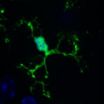(Press-News.org) Toxins produced by plants and bacteria pose a significant threat to humans, as emphasized by the recent effects of cucumber-borne Shiga toxin in Germany. Now, new research published on July 21st by the Cell Press journal Developmental Cell provides a clearer view of the combination of similar and divergent strategies that different toxins use to invade a human host cell.
Ricin is a highly toxic protein derived from the castor bean plant that has raised concerns as a potentially lethal biological weapon. Pseudomonas Exotoxin A (PE) is a sometimes deadly protein produced by a common bacterium that can infect the lungs and urinary tract. "Although from very different origins, both PE and ricin share several points in common," says senior study author, Dr. Frédéric Bard from the Institute of Molecular and Cell Biology in Singapore. "Like many other toxins, they have evolved mechanisms for hijacking intracellular membrane transport processes." Previous research has identified some of the proteins made by our own cells that are used by the toxins. In theory, disrupting these proteins, or the genes that make them, could serve as a useful toxin antidote. However, the extent to which different toxins share requirements for the host proteins they use was not clear.
Dr. Bard and colleagues discovered that many different proteins are required for maximum toxicity of ricin and PE, and the requirements of both toxins differ significantly and at multiple levels. However, the pathways used by the toxins do exhibit some similarities. "Interestingly, the toxins share some genetic requirements, and exhibit similar sub-cellular localizations at various levels of their trafficking, suggesting two intertwined pathways converging and diverging at multiple levels," explains Dr. Bard.
Although the reason for this complexity is not clear, understanding toxin trafficking at the genetic level may prove useful for designing treatments that target these and other similar potentially deadly toxins. "Our study provides a number of potential therapeutic targets to design specific toxin antidotes. Understanding and targeting specific pathways will likely allow a better control of possible side effects," concludes Dr. Bard. "Additionally, the high number of genes involved also suggests that synergistic drug therapies against these types of toxins could be designed."
### END
Targeting toxin trafficking
2011-07-22
ELSE PRESS RELEASES FROM THIS DATE:
Breastfeeding may prevent asthma
2011-07-22
Feeding a baby on only breast milk and for up to 6 months after birth can reduce their risk of developing asthma-related symptoms in early childhood, according to new research.
The study, which is published online today (21 July 2011) in the European Respiratory Journal, looked at the impact of the duration of breastfeeding and the introduction of alternative liquids or solids in addition to breast milk.
The researchers, from the Generation R Study, Erasmus Medical Center in The Netherlands, used questionnaires to gather data from over 5,000 children. They ascertained ...
Proteins enable essential enzyme to maintain its grip on DNA
2011-07-22
COLUMBUS, Ohio – Scientists have identified a family of proteins that close a critical gap in an enzyme that is essential to all life, allowing the enzyme to maintain its grip on DNA and start the activation of genes.
The enzyme, called RNA polymerase, is responsible for setting gene expression in motion in all cells. RNA polymerase wraps itself around the double helix of DNA, using one strand to match nucleotides and make a copy of genetic material.
RNA polymerase cannot fall off of the DNA or stop this process once it starts. If it does, no proteins will be made, ...
UNC researchers identify seventh and eighth bases of DNA
2011-07-22
(Embargoed) CHAPEL HILL – For decades, scientists have known that DNA consists of four basic units -- adenine, guanine, thymine and cytosine. Those four bases have been taught in science textbooks and have formed the basis of the growing knowledge regarding how genes code for life. Yet in recent history, scientists have expanded that list from four to six.
Now, with a finding published online in the July 21, 2011, issue of the journal Science, researchers from the UNC School of Medicine have discovered the seventh and eighth bases of DNA.
These last two bases – called ...
Working mothers and the effects on children
2011-07-22
Parents struggling to combine paid work with bringing up their children now have some positive news thanks to a new study funded by the Economic and Social Research Council (ESRC) on maternal employment and child socio-emotional behaviour in the UK. The research shows that there are no significant detrimental effects on a child's social or emotional development if their mothers work during their early years.
The ideal scenario for children, both boys and girls, was shown to be where both parents lived in the home and both were in paid employment. For children living with ...
Gardening in the brain
2011-07-22
Gardeners know that some trees require regular pruning: some of their branches have to be cut so that others can grow stronger. The same is true of the developing brain: cells called microglia prune the connections between neurons, shaping how the brain is wired, scientists at the European Molecular Biology Laboratory (EMBL) in Monterotondo, Italy, discovered. Published online today in Science, the findings could one day help understand neurodevelopmental disorders like autism.
"We're very excited, because our data shows microglia are critical to get the connectivity ...
Identical virus, host populations can prevail for centuries, WHOI researcher reports
2011-07-22
A Woods Hole Oceanographic Institution (WHOI) scientist, analyzing ancient plankton DNA signatures in sediments of the Black Sea, has found for the first time that the same genetic populations of a virus and its algal host can persist and coexist for centuries. The findings have implications for the ecological significance of viruses in shaping algae ecosystems in the ocean, and perhaps fresh water as well.
"The finding that the DNA of viruses and algal host cells can be preserved in the geological records is of great interest to microbial ecologists," said Marco Coolen ...
Plan to one day end the use of environmentally harmful chemicals on commercial crops developed
2011-07-22
(Edmonton) Two University of Alberta researchers have published a step by step plan to one-day end the use of environmentally harmful chemicals on commercial crops by developing plants that produce their own fertilizer.
U of A plant biologist Allen Good says the energy required to produce nitrogen fertilizers has pushed the world-wide cost for agricultural producers to a $100 billion a year. Good says that while they are necessary for high yields, those nitrogen fertilizers also damage the environment. Emissions from nitrogen fertilizers add to greenhouse gas emissions ...
Repairing our inner clock with a 2-inch fish
2011-07-22
Tel Aviv — Circadian rhythms — the natural cycle that dictates our biological processes over a 24-hour day — does more than tell us when to sleep or wake. Disruptions in the cycle are also associated with depression, problems with weight control, jet lag and more. Now Prof. Yoav Gothilf of Tel Aviv University's Department of Neurobiology at the George S. Wise Faculty of Life Sciences is looking to the common zebrafish to learn more about how the human circadian system functions.
Prof. Gothilf and his Ph.D. student Gad Vatine, in collaboration with Prof. Nicholas Foulkes ...
Washing away good and bad luck
2011-07-22
RIVERSIDE, Calif. (www.ucr.edu) -- Do people believe good and bad luck can be washed away?
Yes, according to an advanced online publication in the Journal of Experimental Psychology that was co-authored by Rami Zwick, a University of California, Riverside marketing professor in the School of Business Administration.
Zwick, working with Alison Jing Xu of the University of Toronto, and Norbert Schwarz of the University of Michigan, designed two experiments that showed risk taking depends on whether participants recalled a past episode of good or bad luck and whether they ...
Do we buy cosmetics because they are useful or because they make us feel good?
2011-07-22
A study by the University of the Basque Country (UPV/EHU) shows that people who use cosmetics buy these products primarily for emotional reasons. The study was carried out on facial creams (hydrating and nutritive ones, coloured or non-coloured, and anti-wrinkle creams) and body creams (firming and anti-cellulite creams).
"The study shows that both the emotional and utility aspect of cosmetic brands have a significant impact on consumer satisfaction, but that the emotional component has a greater effect", Vanessa Apaolaza, a researcher from the UPV and lead author of ...


